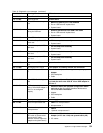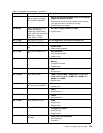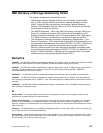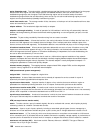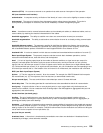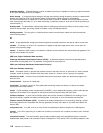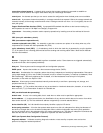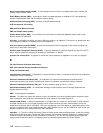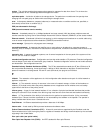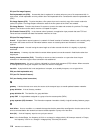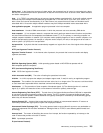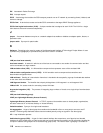attention (ATTN). An occurrence external to an operation that could cause an interruption of the operation.
AUI (see attachment unit interface).
authentication. In computer security, verification of the identity of a user or the user’s eligibility to access an object.
auto-removal. The removal of a device from data-passing activity without human intervention. This action is
accomplished by the adapter in the device, and can be initiated by a network management program.
B
balun. A transformer used to connect balanced cables, such as twisted-pair cables, to unbalanced cables, such as
coaxial cables, by matching the electrical characteristics of the cables.
bandwidth aggregation. The ability to establish more than one communication channel per connection.
bandwidth augmentation. The ability to add another communication channel to an already existing communication
channel.
bandwidth-distance product. The parameter specified for bulk fiber that defines the distance that a signal at a
defined frequency can be transmitted with a specified loss, usually half the power at zero frequency. Use of a fiber
with a bandwidth-distance product of 500 MHz-km would support 250 MHz for a distance of 2 km.
baseband LAN. A local area network in which data are encoded and transmitted without modulation of a carrier (T).
Basic Input/Output System. The personal computer code that controls basic hardware operations, such as
interactions with diskette drives, hard disk drives, and the keyboard.
baud. (1) A unit of signaling speed equal to the number of discrete conditions or signal events per second; for
example, one baud equals one-half dot cycle per second in Morse code, one bit per second in a train of binary
signals, and one 3-bit value per second in a train of signals each of which can assume one of eight different states
(A). Contrast with bits per second. (2) In asynchronous transmission, the unit of modulation rate corresponding to one
unit interval per second; that is, if the duration of the unit interval is 20 milliseconds, the modulation rate is 50 baud.
BIOS (see Basic Input/Output System).
bit-time. (1) The time required to transmit 1 bit on the network. For example, the IBM PC Network bit-time equals
500 nanoseconds (ns). (2) The reciprocal of the line data rate (or network data transfer rate).
bits per second (bps). The rate at which bits are transmitted per second. Contrast with baud.
block delay time. The time delay permitted for received frames to be assembled into blocks for retransmission.
bond group. A logical collection of two or more physical ports (on a per engine basis only) that becomes one
interface on the network. You can create two kinds of bond groups in the NAS appliance: aggregated links (see link
aggregration) and active-backup.
bonded interface (see bond group).
bonding. The act of combining two or more physical ports to create one logical network interface with one
associated IP address. Bonding can improve performance by either increasing bandwidth (see link aggregation) or
providing port backup (see active-backup).
bootstrap. (1) A sequence of instructions whose execution causes additional instructions to be loaded and executed
until the complete computer program is in storage (T). (2) A technique or device designed to bring itself into a desired
state by means of its own action, for example, a machine routine whose first few instructions are sufficient to bring the
rest of itself into the computer from an input device (A).
bps (see bits per second).
broadcast frame. A frame that is simultaneously transmitted to more than one destination. A broadcast frame is
forwarded by all bridges, unless otherwise restricted.
IBM Glossary of Storage Networking Terms 109



